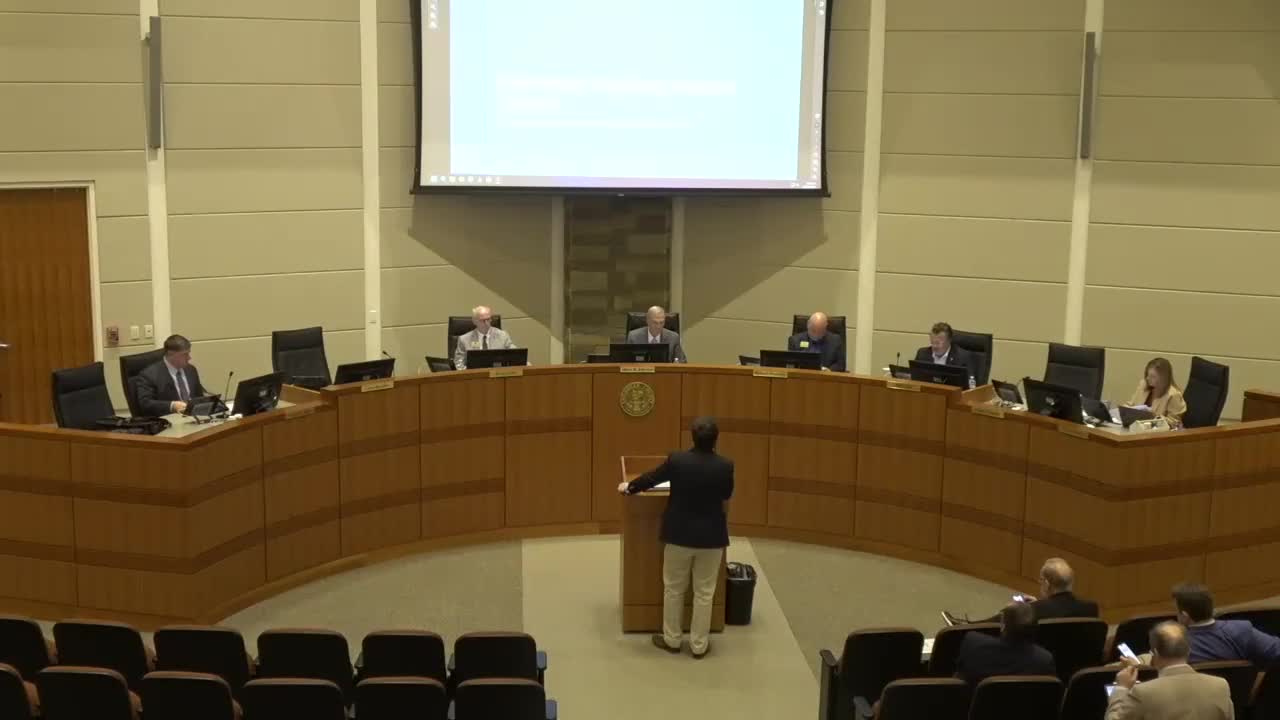Cherokee County staff propose workforce housing overlay to reserve homes for local employees
October 21, 2025 | Cherokee County, Georgia
This article was created by AI summarizing key points discussed. AI makes mistakes, so for full details and context, please refer to the video of the full meeting. Please report any errors so we can fix them. Report an error »

Cherokee County planning staff on Oct. 21 presented a draft “workforce housing overlay district” intended to help people who work in the county — including teachers, healthcare workers and first responders — also afford to live there.
Planning senior staffer Mr. Trawick told the Board of Commissioners the draft would be added to Article 16 of the county zoning ordinance and set conditions for where and how developments could qualify for the overlay. “We’re promoting homeownership here for those who live and work in Cherokee County earning at or below 80% the AMI,” Trawick said, noting staff used July 2025 market figures and agency guidance to frame the proposal.
The draft would reserve units for households earning 80% or less of area median income (AMI) — staff estimated 100% AMI in Cherokee County as roughly $103,000–$106,000, making the 80% target about $86,400 — and would favor for-sale housing (single‑family detached, duplexes or townhomes, not apartments). Proposed site criteria include infill parcels of 10 acres or less, public water and sewer, location within two miles of I‑575 or State Route 92, and at least 75% of surrounding parcels developed or under construction. The draft sets a maximum density of 10 dwelling units per acre, a 50‑foot exterior building setback with a 35‑foot exterior buffer, a 10% minimum green space requirement and building height limits.
To preserve affordability, staff proposed requiring long‑term protections such as a 30‑year deed restriction or a land‑use restriction agreement recorded before final plat approval. Staff also described tools jurisdictions sometimes use to preserve affordability, including a subordinate second mortgage to assist with down payments and covenants or “good neighbor” agreements to identify maintenance and enforcement responsibilities.
Why it matters: Planning staff said employers including Northside Hospital, Wellstar and the school district have told county leaders they face workforce housing shortages. The overlay is presented as one tool to encourage local homeownership for workers earning up to 80% AMI and to implement goals from the county comprehensive plan.
Commissioner reaction and next steps: Commissioners asked technical questions about whether the proposed density would favor townhomes and duplexes rather than single‑family lots, how accessory dwelling units (ADUs) relate to the proposal, and whether other jurisdictions use a similar floating overlay. Trawick said staff had not found another jurisdiction using a floating overlay for workforce housing and contrasted the overlay with inclusionary zoning approaches used elsewhere. No formal vote was taken; the chair asked whether the board wanted to advertise a public hearing on an ordinance amendment tonight. Commissioners requested two weeks to review the draft and to hear from Commissioner Ragsdale before deciding whether to add a hearing to the agenda.
Planning senior staffer Mr. Trawick told the Board of Commissioners the draft would be added to Article 16 of the county zoning ordinance and set conditions for where and how developments could qualify for the overlay. “We’re promoting homeownership here for those who live and work in Cherokee County earning at or below 80% the AMI,” Trawick said, noting staff used July 2025 market figures and agency guidance to frame the proposal.
The draft would reserve units for households earning 80% or less of area median income (AMI) — staff estimated 100% AMI in Cherokee County as roughly $103,000–$106,000, making the 80% target about $86,400 — and would favor for-sale housing (single‑family detached, duplexes or townhomes, not apartments). Proposed site criteria include infill parcels of 10 acres or less, public water and sewer, location within two miles of I‑575 or State Route 92, and at least 75% of surrounding parcels developed or under construction. The draft sets a maximum density of 10 dwelling units per acre, a 50‑foot exterior building setback with a 35‑foot exterior buffer, a 10% minimum green space requirement and building height limits.
To preserve affordability, staff proposed requiring long‑term protections such as a 30‑year deed restriction or a land‑use restriction agreement recorded before final plat approval. Staff also described tools jurisdictions sometimes use to preserve affordability, including a subordinate second mortgage to assist with down payments and covenants or “good neighbor” agreements to identify maintenance and enforcement responsibilities.
Why it matters: Planning staff said employers including Northside Hospital, Wellstar and the school district have told county leaders they face workforce housing shortages. The overlay is presented as one tool to encourage local homeownership for workers earning up to 80% AMI and to implement goals from the county comprehensive plan.
Commissioner reaction and next steps: Commissioners asked technical questions about whether the proposed density would favor townhomes and duplexes rather than single‑family lots, how accessory dwelling units (ADUs) relate to the proposal, and whether other jurisdictions use a similar floating overlay. Trawick said staff had not found another jurisdiction using a floating overlay for workforce housing and contrasted the overlay with inclusionary zoning approaches used elsewhere. No formal vote was taken; the chair asked whether the board wanted to advertise a public hearing on an ordinance amendment tonight. Commissioners requested two weeks to review the draft and to hear from Commissioner Ragsdale before deciding whether to add a hearing to the agenda.
View full meeting
This article is based on a recent meeting—watch the full video and explore the complete transcript for deeper insights into the discussion.
View full meeting
